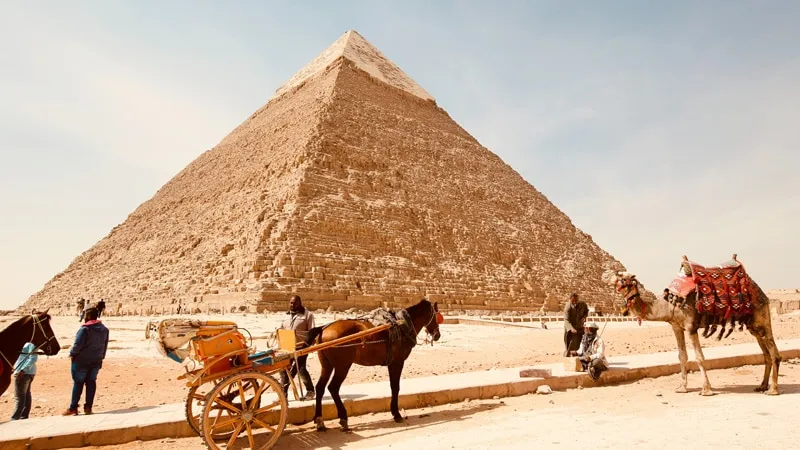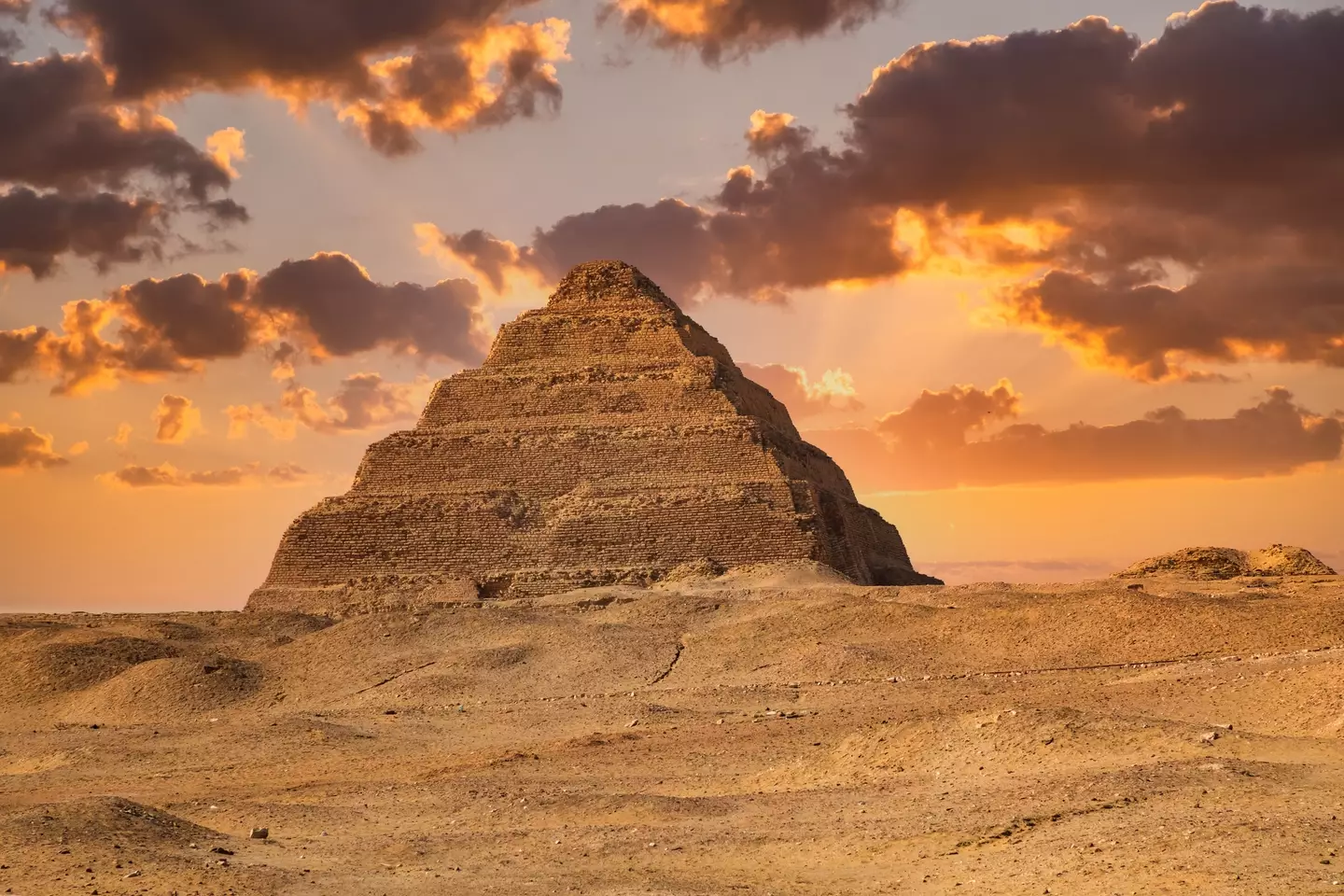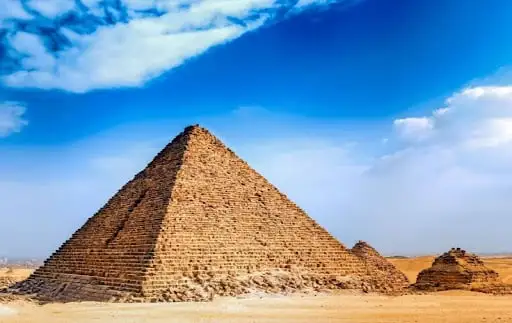The Pyramid of Khafre, also known as the Pyramid of Chephren, is the second largest pyramid at Giza and stands as a mighty symbol of ancient Egyptian architectural skill and royal power. Alongside its famous neighbor, the Great Pyramid of Khufu, Khafre’s pyramid dominates the Giza Plateau with unparalleled grandeur. This monument not only serves as the tomb of Pharaoh Khafre but also houses some of the most intriguing mysteries and artistic achievements of old Egypt. With Desert Cruise, visitors get to experience the Pyramid of Khafre like never before blending history, culture, and desert magic into a uniquely memorable tour.
History of the Pyramid of Khafre
Built during the Fourth Dynasty around 2570 BC, the Pyramid of Khafre was commissioned by Pharaoh Khafre, the son of Khufu. Standing originally at 143.5 meters tall, it appears taller than Khufu’s pyramid due to its elevated location on the Giza Plateau and the remaining smooth limestone casing at its peak. The pyramid complex also includes the Valley Temple, the Mortuary Temple, and the incredible Great Sphinx believed to be a guardian statue carved directly from the bedrock in Khafre’s likeness. This complex was a vital religious and burial site, reflecting the deep spiritual beliefs surrounding death and immortality in ancient Egypt.
How Was the Pyramid of Khafre Built?
The Pyramid of Khafre was constructed primarily using massive limestone blocks quarried locally, weighing between 2.5 and 15 tons each. Workers likely used a sophisticated system of ramps, levers, and organized labor forces to transport and assemble these stones with remarkable precision. Unlike the Great Pyramid, parts of Khafre’s original smooth limestone casing still remain near its apex, giving visitors a glimpse of its original polished exterior. The pyramid’s internal chambers and passageways, including the burial chamber and the antechamber, showcase skilled masonry and a complex architectural design aimed at protecting the Pharaoh’s remains and ensuring safe passage to the afterlife.
Location of the Pyramid
The Pyramid of Khafre sits majestically on the Giza Plateau, slightly southwest of the Great Pyramid of Khufu. Its elevated position creates a visually dominant silhouette that can be seen from Cairo’s outskirts. The pyramid’s proximity to the Great Sphinx, which is thought to represent Khafre himself, emphasizes its importance within the necropolis. The location was selected not only for strategic and religious reasons but also to establish the Pharaoh’s eternal connection to the divine and the cosmos.
What Makes the Pyramid of Khafre Unique?
The Pyramid of Khafre is unique for several reasons. It retains some of its original smooth casing stones at the top, a rare sight among the Giza pyramids. Its association with the Great Sphinx the mysterious and colossal statue that has captivated historians and tourists for centuries further enhances its fame. The pyramid complex is also notable for the well-preserved temples and causeways that reflect intricate religious rituals. The scale, alignment, and construction methods demonstrate the Egyptians’ mastery over both engineering and religious symbolism.
Fascinating Facts About the Pyramid of Khafre
- The Pyramid of Khafre was originally 143.5 meters tall but now stands at about 136.4 meters due to the loss of some casing stones.
- It is the only Giza pyramid with the Great Sphinx statue, believed to be carved in Pharaoh Khafre’s likeness.
- The pyramid was built with a core of locally quarried limestone and a casing of fine Tura limestone.
- Workers used copper tools, ropes, sledges, and ramps in an organized labor system to build the pyramid.
- The remaining casing stones at the top are evidence of the pyramid’s original smooth exterior finish.
- The Mortuary Temple adjacent to the pyramid was a place of ritual and offerings to honor the deceased Pharaoh.
- Modern technology and archaeological research still uncover new discoveries about pyramid construction and religious significance.
The Pyramid of Khafre aligns closely to the points of the compass, showing the Egyptians’ advanced astronomical knowledge.
How Desert Cruise Makes Your Visit Special
Desert Cruise offers visitors unrivaled tours around the Pyramid of Khafre, combining expert guides and accessible, comfortable travel experiences. From camel rides across the desert sands to exclusive sunset views illuminating the pyramids in golden light, the tours bring history vividly to life. Personalized itineraries and access to less crowded areas allow visitors to absorb the grandeur and mystery of Khafre’s pyramid in depth. With Desert Cruise, walking among monuments that are thousands of years old becomes an emotional and inspiring journey.
Conclusion
The Pyramid of Khafre stands as one of the most magnificent monuments of ancient Egyptian civilization, reflecting the remarkable architectural skill and deep religious belief of the pharaohs. Its strategic location on the Giza Plateau, alongside the majestic Great Sphinx, makes the pyramid a lasting symbol of Khafre’s power and legacy.
The mysteries surrounding its construction and intricate design continue to inspire scholars and visitors alike, making a visit to the Pyramid of Khafre both an educational and awe-inspiring experience. With Desert Cruise, visitors can enjoy a unique journey that combines rich history with the stunning beauty of the surrounding desert landscape.




